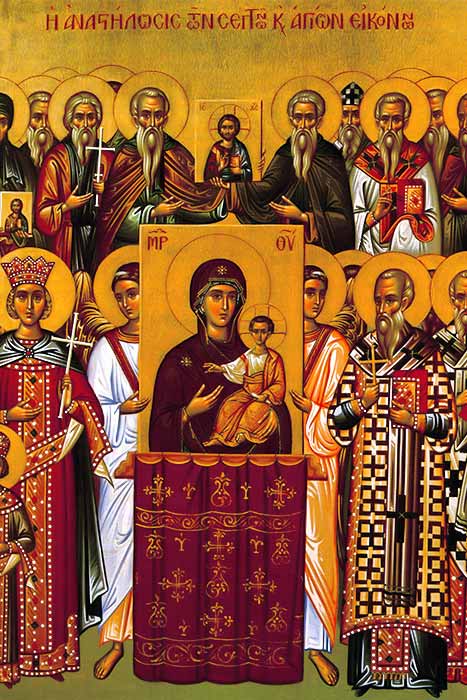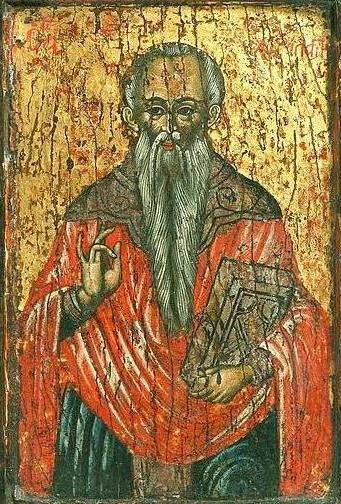For it was fitting that we should have such a high priest, holy, blameless, unstained, separated from sinners, exalted above the heavens. He has no need, like those high priests, to offer sacrifices daily, first for his own sins and then for those of the people; he did this once for all when he offered up himself. Indeed, the law appoints men in their weakness as high priests, but the word of the oath, which came later than the law, appoints a Son who has been made perfect for ever. Now the point in what we are saying is this: we have such a high priest, one who is seated at the right hand of the throne of the Majesty in heaven, a minister in the sanctuary and the true tent which is set up not by man but by the Lord.
Hebrews 7:26-28; 8:1-2 (Epistle from Feast of St. John Chrysostom)
The Book of Leviticus reads like a law book. It was the first “priests’ handbook.” The order of the priesthood was introduced in the Old Testament, many centuries before Christ walked the earth. In order to be a priest, one had to be from the tribe of Levi (one of the twelve tribes of Israel). The priests had certain duties in the temple, as well as in society. For instance, if you recall the story of the ten lepers in Luke 17:12-19, it was the priests who determined is a person was “clean” of disease and could be part of general society, or if they were unclean and needed to be isolated. It was the priests who determined whether animals offered in sacrifices were acceptable or not. This actually led to abuses by the priests, where animals deemed unacceptable could be exchanged for the animals being sold in the temple, for a sizable mark-up, of course. From all the priests, one was chosen each year to be the “high priest.” Only the high priest would enter the Holy of Holies, the innermost part of the sanctuary. Because there was a curtain over the Holy of Holies, no one could be sure of what the high priest would actually do in the innermost altar. As we read in Hebrews 7:28 “Indeed the law appoints men in their weakness as high priests.” And indeed there were many high priests that fell prey to human weakness. Take as an example, Caiaphas, the high priest who handed Jesus Christ, the Son of God, over to the Romans for crucifixion.
Jesus Christ has among other “titles” “High Priest.” This is why He is depicted on the Bishop’s throne in most Orthodox Churches, clad in the vestments of a bishop. Unlike the high priests of the Jewish Temple, and the priests and bishops of today, He is “holy, blameless, unstained, separated from sinners, exalted above the heavens.” (Hebrews 7:26) Like the high priests, He offered a sacrifice, but it was not the sacrifice of animals in the temple on a daily basis. He sacrificed “once for all when He offered up Himself.” (Hebrews 7:27)
Since the Resurrection of Christ, things have changed in the “temple” in which we worship. First, there is no curtain that obscures the Holy of Holies. When there is a service, the royal gates before the Holy Altar are opened, so that people can see the priest. (The exception to this is during Great Lent, when the curtain over the altar is closed, reminding us of how the temple was prior to the crucifixion.) The priest does not enter the holy of holies once a year, but enters often, to offer the Divine Liturgy and the other services of the Church. And the “sacrifice” that the priest offers is not one made with blood, but is bloodless. Instead of offering the blood of animals, we offer bread and wine which are consecrated to become the Body and Blood of Christ.
Jesus Christ, the consummate high priest, “is seated at the right hand of the throne of the Majesty in heaven, a minister in the sanctuary and the true tent which is set up not by man but by the Lord.” (8:1-2) Christ sits at the right hand of God, but is also present in every Divine Liturgy, as His Body and Blood are “forever eaten but never consumed.” (From the Divine Liturgy of St. John Chrysostom) And while our churches are built by human beings, and they are led by human beings (the priests), the true head of the church is Christ.
St. John Chrysostom, as we know, was the author of the Divine Liturgy which bears his name. This Divine Liturgy was actually and editing of the Divine Liturgy of St. Basil the Great, which was an editing of the Divine Liturgy of St. James. It is St. John Chrysostom’s Divine Liturgy, however, which we celebrate most often, on most Sundays and Feastdays of the year. (Saint Basil’s Divine Liturgy is celebrated ten times a year and St. James’ Liturgy is celebrated on October 23.) Saint John Chrysostom is the patron saint of priests. Hence the Epistle lesson from Hebrews talks about the foundation of the priesthood in the Old Testament, contrasted with the priesthood of Christ, which is the foundation of the priesthood that is practiced today.
Indeed priests are still very fallible. I know this because I am a priest and I make mistakes all the time. Christ is the consummate priest. He is the model for what a priest should be. He is a model that I fall short of on a daily basis. The Divine Liturgy is the model for what heaven will be like. It will take us our whole lives, probably, to understand this. It will take us an entire lifetime to prepare to celebrate it in heaven with Christ. In some ways, we are like the Old Testament temple. We celebrate in a ritualistic way and sometimes we forget the substance of what we are doing. We also celebrate in our human weaknesses and frailties. Yet we are still called to celebrate and to strive, so that one day we will be able to worship in “the true tent (heaven) which is set up not by man but by the Lord.” (8:2)
The grace that from your mouth shone forth like a torch illumined the universe. It deposited in the world the treasures of the absence of avarice. It showed us the height that is attained by humility. Now you instruct us by your words, Father John Chrysostom. Intercede with Christ God, the Word himself, entreating Him to save our souls. (Apolytkion of St. John Chrysostom, Trans. By Fr. Seraphim Dedes)
Let us go to our earthly temples, our church, even in our weakness, and worship, so that our weaknesses can be strengthened by the true High Priest, Jesus Christ, as we receive Him in the Eucharist.

